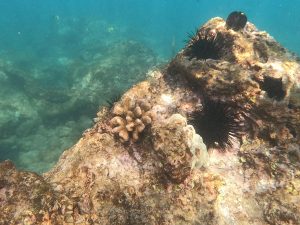
It’s a rite of Spring in the coastal waters on Hawai‘i Island, and across the Hawaiian archipelago, and the time to let coral colonies rest during their short spawning windows.
Parking at the Waialea Bay Marine Life Conservation District (MLCD) will be closed during the mornings of May 17, 18, and 19 to allow spawning and the production of new keiki offspring.
Known, on the Big Island, as “Beach 69”, the 35-acre Waialea Bay is one of eleven MLCDs in Hawai‘i. These districts are revered worldwide as marine protected areas to help perpetuate their rich abundance of aquatic life, beginning with coral reefs as their foundation. MLCDs enjoy the highest levels of protection.
Staff from the DLNR Division of State Parks (DSP) is assisting biologists and technicians with the DLNR Division of Aquatic Resources (DAR) in asking visitors to stay out of the water during these temporary rest periods, which allow corals to spawn and then settle back down.
DAR lead coral monitoring technician Nathan Hayes said, “Our reefs have been damaged in the past few years and since corals are slow growing animals, recovery takes time. One of the best ways everyone can help is to be mindful of our land and ocean activities during times of coral spawning. Only a small percentage of the gametes from these spawning events survive to begin new coral colonies. We want to give them every opportunity to grow into their next phase of life in the open ocean and to begin recruiting more corals.
This is the second annual spawning parking access closure at Waialea Bay MLCD. Kahalu‘u Bay has had similar closures the last two years and will be closed again for this year’s spawning event from May 16 to May 21.
Christopher Teague, a DAR aquatic biologist explained, “The absence of swimmers and snorkelers in the water during coral spawning will limit stressors such as sunscreens, personal care products, and other chemicals. Corals are easily disturbed by people in the water during these critical morning windows and research has shown the chemicals on our skin and even in our bodies may interact with and impact fragile coral larvae. Corals spawn during specific moon and tidal cycles in the Spring.
DAR Administrator Brian Neilson added, “We want to give corals every chance possible to reproduce. Cauliflower corals were especially hard-hit in 2015 and 2019 when elevated ocean temperatures led to mass bleaching events. Along with all the other environmental stressors our reefs currently face, we really encourage ocean users to put up with a bit of inconvenience during spawning.”
Waialea Bay MLCD parking access reopens at noon next Tuesday, Wednesday, and Thursday. Biologists hope people will delay ocean activities at the MLCD for at least an extra day. It can take up to 24-hours for corals to successfully reproduce and up to a week or more for new larvae to settle back onto reefs.



